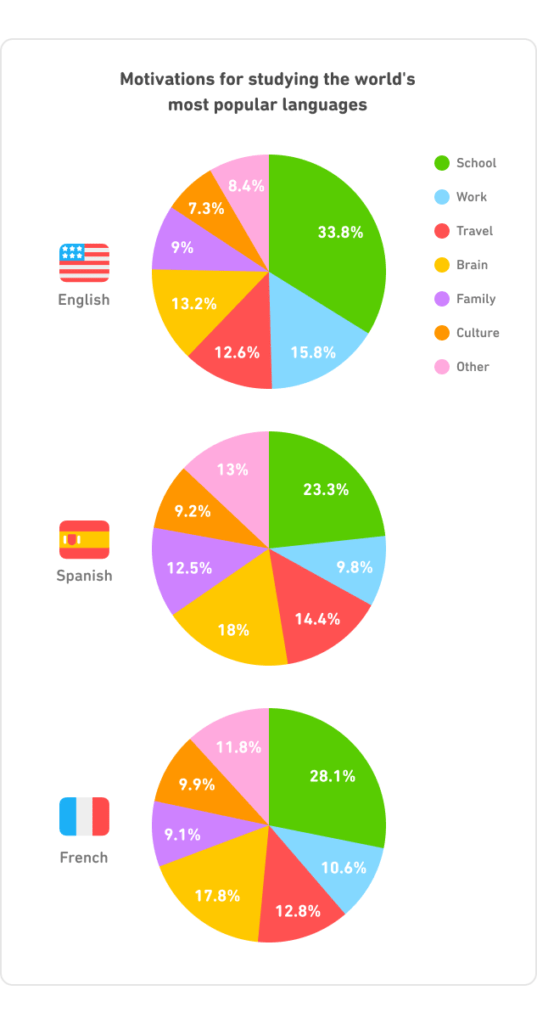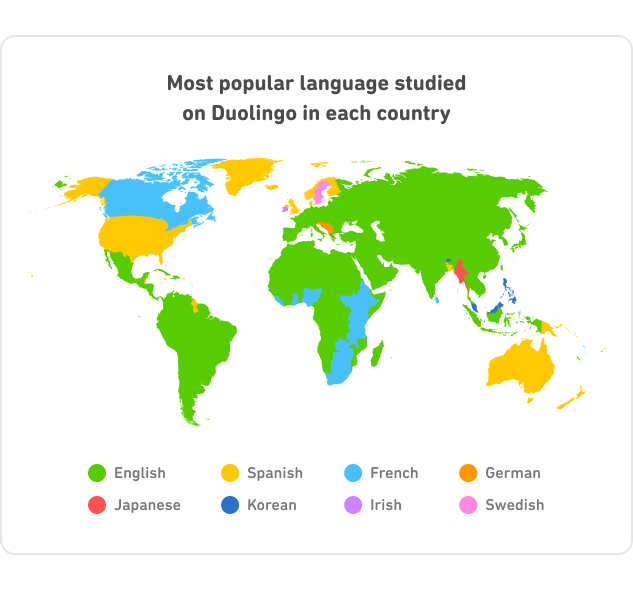Duolingo Releases Global Language Report
31st January 2021
Duolingo released its first Global Language Report at the end of 2020, illustrating patterns, trends and analyses about language learning around the world. The report investigates which countries study which languages, how interest in learning different languages has changed over time and how learner behaviour varies around the world.
The data is based on a 12-month time period between October 2019 and September 2020.
Duolingo has over 500 million users in 194 countries and offers 98 language courses, featuring 39 different languages.
Top findings from the report:
- 30 million new people took up language learning during the lockdown. The biggest spike was seen in March 2020. The increase in learners in each country was directly linked to the time when the country announced their lockdowns. China saw the first wave of new learners, when they locked down on February 20th, with waves of new learners joining the platform each week, with a massive increase of 300% in March and April.

- The scale of growth in language learning varied by country, but Iraq topped the list with a 640% growth in new learners during March/April 2020 compared to the same dates in 2019.
- 27.9% of learners reported school as the main motivator for studying a language and 15.9% claimed that brain training was their main reason. Unsurprisingly travel wasn’t a motivator in 2020, with several travel restrictions imposed by various countries.

- English remained the most popular language to study worldwide. English is the top language to study in 121 countries (62% of all countries), and it’s the second-most popular in an additional eight countries. Ability to speak English is often connected to better career and educational opportunities. For example, Yemen, Vietnam, the Dominican Republic, Burkina Faso, Saudi Arabia, and Guatemala top the list of English-learning countries, with 70%-80% of all learners studying English.
- Spanish and French were the next most popular languages to study. Previously French has dominated as the world’s lingua franca and was the top language to study in 35 countries (according to analysis from 2016). The tables have turned in 2020 and Spanish has overtaken French. Today, Spanish is the most popular language to study in 34 countries, and French has dropped down to 23 countries. Au revoir François!
- Asian and endangered languages are studied more than Italian. The list of second most popular languages increased from 9 languages in 2016 to 16 in 2002. The 2020 list includes several European languages as well as 5 Asian languages (Japanese, Chinese, Korean, Hindi, Turkish) and an African language (Swahili).
- The languages studied around the world reflect immigration, history, economic opportunity and travel interests. These compound connections between people and languages are why French is a popular language in parts of Africa and why German is studied throughout the Balkans.

- Japanese is now the 6th most popular language to study, with nearly as many people learning Japanese as there are learning Italian.
- The Irish language, Gaelic, has taken the top spot in Ireland, overtaking Spanish as the most popular language to study.
- Scandinavian countries with large numbers of learners of their own languages include Sweden, Denmark, and Norway. The report shows that half of these learners are studying their country’s language for work or school, and that immigrant communities in Scandinavia are committed to learning Swedish, Dutch and Norwegian.
- In 2020, Brunei, Bhutan, Malaysia, and Myanmar are the only countries where English, Spanish, and French are not ranked in either of the top two spots. Since 2016, these Southeast Asian countries have moved towards studying Korean, Japanese, and Chinese more than the traditional top three.
- When Duolingo tried to establish the general mood of 2020 by asking their learners to vote on the ‘Most 2020 Duolingo Phrase’ of the year, the one that received the most votes was “I am eating bread and crying on the floor” from its Norwegian course. We didn’t see that coming!
- The world is now learning more Asian languages, with all five of the fastest growing languages being Asian. These languages include Hindi, Korean, Japanese, Turkish and Chinese. The study finds that Korean is the second fastest growing language in the world and is ranked at #7 worldwide as the most popular language to study. There has also been an increase in Asian language learners in the UK, with Hindi and Japanese both up 41% in 2020, followed by Turkish and French, both up 35%.
- Germany surpassed Japan and became the country with the hardest-working learners. With Germany at top spot and Japan at #2, Hungary made 3rd place with Chechia and Poland following closely behind. Looking at the UK only, the hardest-working language learners were found in Hull, Bristol, Edinburgh, Plymouth and Renfrewshire.
- Welsh is the fastest growing language in the UK, with the number of new learners up 44% on 2019.
For more language trends, see the full report here: https://blog.duolingo.com/global-language-report-2020/
